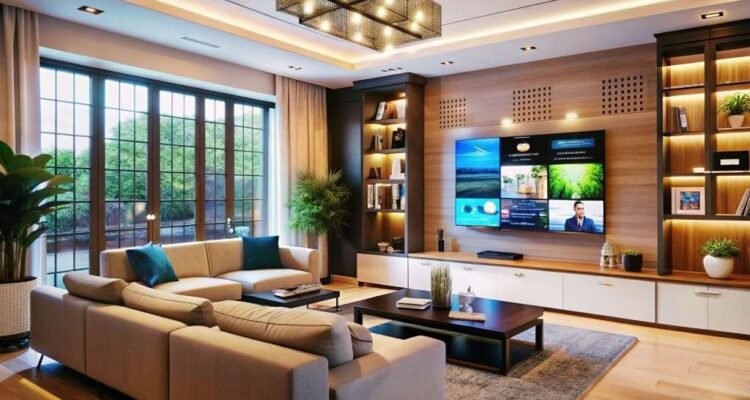Lighting plays a key role in creating the mood and function of a living space. The living room, being one of the most-used areas in any home, needs thoughtful lighting that’s both practical and stylish. Whether you’re reading, watching TV, entertaining guests, or simply relaxing, proper lighting can elevate your entire experience. A professional interior designer in Mangalore will always recommend layering different types of lighting to get the best effect and lamps are a vital part of that equation.
So, how many lamps should you have in a living room? While there’s no one-size-fits-all answer, there are a few simple guidelines that help you decide what works best for your space.
1. Understand the Purpose of the Lamps
Before counting how many lamps you need, it’s important to understand why you need them. Lamps serve different purposes in a living room:
-
Ambient lighting provides overall light for the room.
-
Task lighting is focused on specific areas, like a reading chair.
-
Accent lighting highlights decorative pieces or artwork.
Your lamp choices should include a mix of these to ensure your living room is both functional and beautiful.
2. The Magic Number: 3 to 5 Lamps
Most living rooms do well with three to five lamps, depending on their size, layout, and natural lighting. Here’s how you can divide that up:
-
One or two table lamps: These are perfect for side tables next to the sofa or beside a reading chair.
-
One or two floor lamps: Tall and sleek, these can fill darker corners or stand near seating arrangements.
-
Optional accent lamp: A small decorative lamp for a shelf, console, or mantel can add charm and focus light on a specific area.
Smaller living rooms may only need 2 to 3 lamps, while larger spaces with multiple seating zones might require 5 or more. The idea is to create layers of light, not crowd the room.
3. Match Lamp Size to Room Size
The scale of your lamps should match the size of your living room and furniture. A large floor lamp looks great in a big room but might overwhelm a small space. Similarly, small table lamps work best on side tables or compact spaces.
Choose lamps that not only provide enough light but also blend with your room’s proportions. Oversized lamps in small rooms can feel out of place, while tiny lamps in a large room may get lost visually.
4. Combine Different Types of Lamps
Instead of using the same type of lamp throughout, mix different kinds to make your lighting feel dynamic and stylish:
-
Floor lamps are great for corners or behind a couch.
-
Table lamps add balance on side tables or consoles.
-
Wall-mounted sconces can save space and add soft light.
-
Accent lamps work well for highlighting decorative items.
A good combination of these creates depth and interest in your living room. A skilled interior designer in Mangalore can help you decide which types work best for your layout and style.
5. Think About Lamp Placement
It’s not just about how many lamps you have—it’s also about where you place them. Distribute lamps evenly across the room to avoid dark corners and ensure all areas are well-lit. You want your lighting to feel balanced, not concentrated in one area.
Some effective placements include:
-
On end tables beside a sofa or armchair
-
Behind or next to a sectional couch
-
In corners to brighten up unused space
-
Near bookshelves or decorative displays
-
On console tables at the entry point of the living room
6. Consider the Bulb and Light Temperature
While choosing lamps, pay attention to the bulbs you’ll use. The light temperature (measured in Kelvins) affects how the room feels:
-
Warm white (2700K–3000K): Cozy and relaxing, ideal for living rooms
-
Cool white (3500K–4100K): Bright and energizing, better for task lighting
-
Daylight (5000K+): Very bright and crisp, not commonly used in cozy spaces
Mixing different temperatures can work well, but most living rooms look best with warm white lighting to create a welcoming atmosphere.
7. Style and Decor Compatibility
Lamps are not just for lighting—they’re part of your décor. Choose lamp styles that match your interior design. Whether it’s traditional brass, rustic wood, modern metal, or colorful ceramic, your lamp should enhance the room’s overall aesthetic.
Mangalore homes often blend traditional elements with contemporary designs, so your lamp choices can reflect both. Decorative bases, patterned shades, or locally crafted lamps can all add a personal touch.
8. Don’t Forget About Dimmers
Adding dimmer switches to your lamps (or using smart bulbs) gives you control over brightness levels. This allows you to change the mood of your room—from bright and cheerful during the day to soft and cozy in the evening.
Dimmers are especially helpful when you have multiple lamps. You can light only the areas you’re using and save energy while creating a calm environment.
Final Thoughts
The perfect number of lamps in a living room depends on your room’s size, function, and personal style. Generally, 3 to 5 well-placed lamps can create a layered and balanced lighting setup that makes your space comfortable and visually appealing. Remember to choose the right size, mix styles, and spread them evenly across the room.
For expert help in creating the ideal lighting plan—and matching it beautifully with furniture and décor—consider working with a professional interior designer in Mangalore. Their experience in blending aesthetics with functionality ensures every corner of your home is well-lit and welcoming. And with the finishing touches curated by talented interior decorators in Mangalore, your living room can become a glowing example of stylish, purposeful design.


